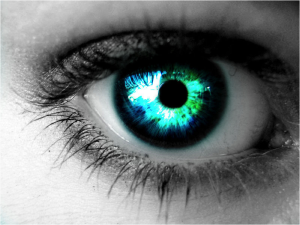So True or So False?
 As a child, your mom most likely nagged you about straining your eyes. Myths about eyesight have been ongoing for centuries. But are these myths true, or are they really just myths? Let’s take a look!
As a child, your mom most likely nagged you about straining your eyes. Myths about eyesight have been ongoing for centuries. But are these myths true, or are they really just myths? Let’s take a look!
Looking at a computer screen for too long can damage your eyes. FALSE
Excessive computer use can cause eye fatigue or discomfort. The computer screens do not cause the discomfort, and the radiation levels are below levels that can cause damage to the eyes. It can cause eyestrain.
Eating carrots will improve your vision. TRUE
Carrots contain Vitamin A, which is essential for eyesight, but only a small amount is necessary.
Reading in the dark can damage your eyes. FALSE
It can only make the eyes tired.
Using improper glasses can damage your eyes. FALSE
Contacts or glasses are necessary to improve eyesight, but not using glasses or contacts will not further damage the eyes.
Swimming in a pool with your eyes open can damage your vision. FALSE
The chlorine from the water can cause irritation and burning of the eyes. It is not dangerous, but uncomfortable. Wearing goggles is the way to go.
Swimming in the ocean with your eyes open can damage the eye if contact is made with dangerous substances like man o’ war tentacles. FACT
Celebrating 4th of July – Independence Day
Honoring our Nation’s independence.
Wishing everyone a safe and happy Independence Day!
God Bless America
Keeping Your Vision Safe During the 4th of July
As we all know fireworks are fun and exciting to watch, but did you know that fireworks injure over 9,000 people each year? Of the 9,000 plus people that are injured, 47% of those people are bystanders. The safest way to enjoy fireworks for this upcoming 4th of July is to remain at least 500 ft. away from where the fireworks are being lit. If you or someone else are setting off fireworks at home or in the street, you should follow these steps:
- Make sure the person lighting the fireworks has protective eyewear.
- Make sure they never try to relight a “dud” firework.
- Make sure only one firework is being lit a time, never attempt to light more than one.
- Never aim a firework at a person, pet, vehicle, house, or any structure or something flammable.
- Always keep a supply of water near by at all times as a safety precaution.
- When storing fireworks, keep them in a cool, dry and safe place, away from children and pets.
- Lastly, one should leave the area where the fireworks are being shot off from, unless it is a trained professional, in which case one should remain at least 500 ft. away.
In the event of a fireworks eye injury, one should: “Get medical attention right away”!
Here is the list of things to avoid:
- Do not rub your eyes
- Do not rinse your eyes
- Do not apply pressure
- Do not apply ointments Do not remove an object from your eye (if one gets stuck there)
- Lastly, do not take blood thinning pain drugs, such as aspirin or ibuprofen.
The fireworks that cause the most injuries are Firecrackers (1200 injuries), Sparklers (600 injuries), and Bottle Rockets (600 injuries). While fireworks are not banned in every state, in order to enjoy fireworks while staying safe this 4th of July, leave the lighting and setting up to the professionals.
Celebrating Senior Independence Month
 July is recognized by The American Academy of Ophthalmology as “Celebrate Senior Independence Month.” As we all celebrate our independence on July 4, we should appreciate the importance of independence to our senior population. The ability to live, and enjoy life independently is taken for granted by many, but becomes a source of increasing concern in an aging population dealing with various maladies, infirmities, and incapacities.
July is recognized by The American Academy of Ophthalmology as “Celebrate Senior Independence Month.” As we all celebrate our independence on July 4, we should appreciate the importance of independence to our senior population. The ability to live, and enjoy life independently is taken for granted by many, but becomes a source of increasing concern in an aging population dealing with various maladies, infirmities, and incapacities.
As Ophthalmologists, we have many patients for whom independent living and functioning becomes more difficult due to vision problems. Thankfully, many of these problems can be avoided, or the effects minimized. Modern treatment of cataracts, glaucoma, macular degeneration, and other retinal diseases have revolutionized our field, and allowed millions of our seniors to continue to function at the highest levels well into their 80’s, 90’s and beyond.
Proper eye care requires regular examinations to detect early disease, before symptoms have even begun. This is especially true with glaucoma and macular degeneration where significant damage can occur before a patient notices a change in vision.
In addition to regular exams, seniors should maintain a healthy lifestyle with proper diet and exercise, avoid smoking, and wear sunglasses while outdoors in our bright Florida sunshine. Wearing proper eye protection is important when playing certain sports or when doing certain household or gardening chores, and especially when working with noxious household chemicals.
If seniors practice proper preventative eye care, and receive regular examinations and timely treatment, they are likely to maintain excellent vision, a crucial ingredient to living and functioning independently.
Keep Your Eyes Young
No one wants to wake up one morning to find wrinkles or bags around their eyes when looking in the mirror. Signs of aging catch most people off guard and before they know it, it’s too late. While you’re attempting to keep your skin looking fresh and radiant with creams and treatments, why not keep your eyes looking young also?
The skin closest to the eye is very sensitive and can easily be affected by one’s lifestyle. Collagen is the protein that maintains the skins firmness and keeps it plump. Cortisol, a hormone released from stress, creates loss of collagen, and the skin in turn thins out. Some signs of aging include crow’s feet, crepe-y eyelids, and dark circles and there are several ways to prevent these changes. The key to keeping the wrinkles and circles away is to follow proper defense mechanisms for the eyes.

• Get at least 8 hours of sleep every night
• Be gentle when applying and removing makeup
• Wear sunglasses to keep you from squinting
• De-stress and find time to relax
• Use hydrating moisturizer with antioxidants
Happy Father’s Day 2014
The Rand Eye Institute would like to take this time and say “Thank You” to all the Fathers out there. For all the time, work, patience, effort, listening, love, care and everything else that you put into being a Father. So once again, “Thank You” and HAPPY FATHER’S DAY!!!
Father’s Day Book Sale
Starting this Wednesday-Friday from 10AM-4PM Rand Eye Institute is having a Father’s Day Book Sale, where 100% of the proceeds will benefit the Rand Eye Foundation. Come out and support and we hope to see you there.
Event: Father’s Day Book Sale
Location:
Rand Eye Institute
5 West Sample Road, Deerfield Beach, FL 33064
Wednesday (June 11) – Friday (June 13), 2014
10AM through 4PM
1st Floor Lobby
WHY the Color of Your Eyes…
Did you know that only one in five Caucasian adults have blue eyes in the U.S.? However, most people are born blue-eyed. The irises will change colors from blue to brown or hazel during a child’s infancy.
Do you know why? This occurs because there is a certain amount of melanin when a child is born, but the changing melanin levels after birth is what affects the color transition. Melanin is a pigment, the more you have in your eyes, skin and hair, the darker they will be, causing them to reflect more sunlight.
 Small amounts of melanin=eyes appear blue
Small amounts of melanin=eyes appear blue
Medium amount of melanin=eyes turn green or hazel
Large amount of melanin=eyes turn brown
June is Cataract Awareness Month
June is Cataract Awareness Month, so make the most of it while learning about how to keep your eyes safe and healthy. A cataract is when the natural lens gets clouded, which is a light-sensitive tissue that helps the eye focus, the result of the clouding could mean distorted or blurred vision. If a cataract is left untreated and is disregarded not only can it impair your vision but it may even cause blindness.
There are many things that can affect ones chances of developing cataracts, such as; family history, radiation, high blood pressure and obesity. Cataracts affect 1/6 of Americans past the age of 40. Once around 75 years old, roughly 70% of people will have cataracts.
Coming to get your vision checked is more than just a monthly or yearly check up, it is about seeing clearly and improving your life with clear vision. Imagine going to see a movie or driving on the road, you might be having a hard time seeing the screen or even a red light. At the end of the day, scheduling an appointment with a licensed ophthalmologist is best way to go. This will help you stay healthy and independent.
KEEP an ‘EYE’ on Hurricane Related Injuries
For Immediate Release: May 30, 2014
Rand Eye Institute offers Hurricane Eye Safety Tips in an Effort to Reduce and Prevent Pre- and Post- Storm Eye Injuries
Deerfield Beach, Fla. — In response to the rising number of hurricane related injuries over the past hurricane seasons, the Rand Eye Institute, a comprehensive eye care and surgical facility in Deerfield Beach, is assisting South Florida residents anticipate and prepare for an increasing number of storm related eye injuries. Rand Eye Institute’s “Hurricane Eye Safety Tips” can be found at: randeye.com
While a number of injuries are directly caused by the storm’s landfall and deteriorating weather conditions, the majority of reported incidents are caused indirectly, occurring as a result of pre- and post-storm preparation and recovery efforts. Of these, 90 percent are avoidable. By taking steps laid out by Rand Eye Institute, before, during and after a storm, many of these potential hazards can be reduced and potentially prevented.
“Eye injuries have increased in past storms. Anticipating and preparing for risks that can potentially lead to an eye injury should be part of any emergency disaster plan,” says William J. Rand, MD chief surgeon and medical director of the Rand Eye Institute.
Because flying fragments of metal, wood, concrete and other building materials, along with windblown dust and debris account for the highest number of eye injuries, one of the simplest ways to prevent eye injuries is to wear protective eye goggles or safety glasses, which should be included with other hurricane supplies. Wearing protective eyewear, even when putting up shutters, removing debris or working with both hand and power tools, can reduce the risk of injuring the eye.
The Rand Eye Institute also recommends:
- Avoid rubbing or touching irritated areas of the eye – especially if you suspect the presence of debris particles or chemical solutions. Wash and rinse with clean, preferably bottled water.
- Having essential medications, including preservative-free eye drops on hand
- Sterilizing contact lenses more frequently – especially when dealing with unsanitary conditions
- Current prescription eye glasses and copy of original prescription
- Preparing a list of all physician emergency contact numbers, including your ophthalmologist and/or optometrist
- Seeking immediate medical attention if you experience a serious eye injury or problem.
Call 954-782-1700 or toll-free 1-800-782-1711
With a compliment of Board Certified Ophthalmologists, who are on call to address your most immediate concerns, the Rand Eye Institute, an emergency generator-powered facility, provides 24-hour emergency care, with an on-site, fully licensed and Joint Commission accredited ambulatory and surgical center, capable of treating a full-range of eye injuries.
Specializing in refractive surgeries such as custom no-flap laser vision correction, lens exchange procedures, custom laser cataract surgery, vitreo-retinal surgery and corneal transplantation; the Rand Eye Institute is a comprehensive eye care and surgical facility, which offers a full-range of patient services, including routine eye examinations, treatment for dry eye syndrome, advanced testing and sophisticated ophthalmic treatments for various eye conditions. The Rand Eye Institute’s compliment of qualified, Board certified doctors and professional staff provide patients with quality and compassionate care.
Located on the first floor is the Rand Surgical Pavillion, a state-of-the-art fully licensed and Joint Commission accredited surgical facility, which offers the highest level of surgical care, surpassing nationally accepted standards for safety, sterility, technology, and quality outcomes.
Founded in 1979 by William J. Rand, M.D., one of the most experienced eye surgeons in the country, the Rand Eye Institute is centrally located in Southeast Florida at 5 West Sample Road in Deerfield Beach, FL 33064. For more information about the Rand Eye Institute, please visit www.randeye.com or call 1-800-782-1711.







